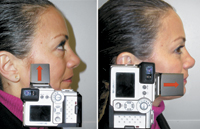
Shadowing can easily be eliminated
by simply rotating the camera so the flash angle
changes. The photo on the left shows an image taken with
the camera upright and the resultant shadow, while the
photo on the right shows the same image without a shadow
taken with the camera rotated 90 degrees. The image is
simply rotated with the imaging software.
|
San Diego — Advances in
digital photography have brought the proverbial mountain to
would-be photographers, making it less time-consuming, and,
let's face it, less daunting when it comes to documenting
procedures and patient outcomes. And with documentation being
an important, albeit time-consuming, factor in a physician's
work, the advent of the digital camera is a boon to the
process. Joseph Niamtu, III, D.M.D., would agree.
"In my 21 years of practice
I have made a constant observation of countless doctors I know
from all specialties of medicine and dentistry... is that the
best doctors take a lot of pictures! [And] they don't just
take the pictures, but they make their images work for them,"
said Dr. Niamtu at the American Academy of Cosmetic Surgery
annual meeting.
Stop stalling
Dr. Niamtu, who practices
Cosmetic Facial Surgery in Richmond Va., says though many
doctors have left slide photography behind to embrace the new
technology, there are still some who haven't. His message to
them: Get with it!
"One common excuse I hear
is that 'things are changing so rapidly, I am going to wait
until better equipment exists.' The message to these
procrastinators is that you cannot outrace technology...Every
day you wait you will be losing opportunities to use your
valuable images."
The very first step to
going digital is buying the equipment, and the initial
investment can be steep, Dr. Niamtu says, but he assures that
it pays for itself several times over. First, you need to
decide on a digital camera. But, if you really want the magic
to happen, you'll also need a computer, printer and imaging
software.
The quest for a digital
camera doesn't need to take on Homeric proportions.
"Most high-end,
off-the-shelf, name brand digital cameras will suffice for
most clinicians. Most of them have adequate macro function for
close-up images and can zoom out enough for full body
pictures.
Because simplicity is key
to prolific documentation, he also recommends checking out any
reputable professional camera company that modifies the camera
software and flash to simplify macro flash photography. For
close-up photography in the macro mode, a standard flash may
not suffice. The flash set up on off-the-shelf cameras is too
close to the subject in most macro situations and will not
illuminate the area. Lens mounted ring or point flashes will
solve this problem, but purchasing a factory modified camera
can produce the same results without bulky or add on flashes.
He adds that the camera
should be simple enough, with automatic settings, so staff
members can pick up, point and shoot during in-surgery photo
ops when the surgeon is scrubbed and otherwise unavailable to
take photos. Also, look for a camera small enough to throw in
a briefcase to take anywhere and use at a moment's notice.
Resolution requirements
Ten years ago, digital cameras
had a grainy 640x480 resolution; today, the technology has
exploded, offering upwards of eight megapixels. The resolution
relates to the actual size of the image, Dr. Niamtu explains.
So how much resolution is enough to produce great images?
"One misconception is that
you constantly need to upgrade to higher megapixel cameras,"
Dr. Niamtu says.
"Granted, the higher the
resolution, the better the picture, but cameras are like
stereo equipment in that after a certain point the differences
are miniscule.... Personally, I feel that there is no need to
take eight megapixel images for routine digital clinical
photography. You just don't need that size and these image
files are very memory-intense."